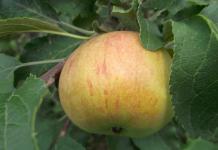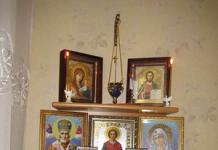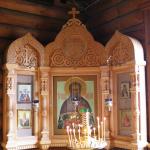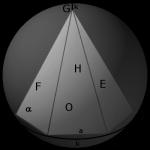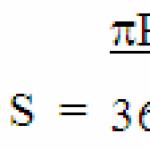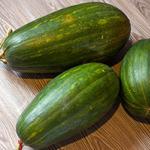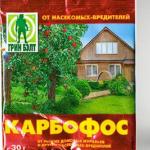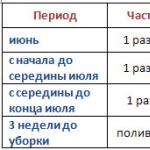Since ancient times, icons have decorated not only the walls of temples and churches, but also the homes of believers. In order for icons to become a talisman for your home, and images of saints to help you in any difficult moment, you need to arrange them correctly.
For Orthodox believers, their own home, like the church, is an important place that needs God’s protection. Icons, as one of the most important objects of religion, should occupy the most honorable place in the house. The faces of saints were always in the most visible place and protected the home and its inhabitants.
Modern people are less likely to attach importance to the correct placement of icons in the apartment, so most often they choose the wrong place for them. So that the icon does not lose its power, and the saints can always hear you, you should consider how and where to correctly place the holy image.
Where should icons be placed in the house?
Very often, not only incorrect placement, but also neighboring objects negatively affect the power of icons. Of course, only you can decide where you would like to see the images of saints in your home, but try to pay attention to those things that will be located next to the icons. Many little things, including photographs, souvenirs and even ordinary figurines, can affect the power of icons, and instead of a talisman they will become an ordinary decoration. If you keep a home library in cabinets, consisting mainly of books that are not of a theological nature, then you should also not try to place holy images there. By choosing the right place to place the icons, you can provide protection for you and your home.

From ancient times to this day, the most correct place to place holy images is the “red corner” - the corner of the house facing east. In Ancient Rus' it was believed that any person entering a house should first of all honor the Lord, and only then the head of the house. Usually a small cabinet was installed there or shelves were hung, where the icons were located. Currently, apartment layouts do not always allow for icons to be installed opposite the entrance. If you do not have the opportunity to organize a “red corner” in your apartment, then the icons can be placed on the right side of the front door.
If there is a small child in the house, then the icons can be hung above his crib: this way you can provide your child with constant protection. In this case, pay attention to the icons of the Mother of God. As the patroness of family and children, she will become a talisman for your apartment and for all household members.
You can place icons in any room, always in a visible place - this will provide maximum protection for you and protect your home from accidents and uninvited guests.
If you decide to place the icon in the kitchen on the dining table, do not forget to pray to God before each meal, so that the Almighty will bless you, and you will thank him for everything that is on your table.
How not to place images of saints
Icons should not be placed next to electrical equipment, since their constant use can weaken the power of the holy image. If you want to place an icon in a workplace where there is a computer, it is advisable to place the icon not on the table, but place it somewhere nearby - on a wall or on a window. In this case, nothing will interfere with the action of the icon, and the holy face will help you in your work.
You cannot place icons with figurines, souvenirs, Feng Shui decorations and other little things, since in the spiritual world icons have a special meaning, and for believers it is unacceptable to equate holy images with ordinary home decor items. For the same reason, you cannot hang icons next to paintings.
You cannot place icons next to photographs or hang them next to posters of famous people. It is believed that in this way during prayer you deify a living person. In this case, your request to the saints is unlikely to be heard.
You cannot place icons on a shelf with books that do not have theological content. Any manuscript takes on the mood and energy of the author, and it is not always positive. In order not to create accumulations of negative energy around icons, it is advisable not to place images of saints in a bookcase.

How to properly place icons in the house
It is advisable to hang icons on the wall or place them on a shelf so that the depicted saints can cover your entire apartment with their gaze, thereby protecting it.
If you decide to place the iconostasis in the “red corner”, purchase a shelf-case. On it it will be more convenient for you to place the icons in a prominent place and, as expected, the images of saints will be facing the entrance.
There must be an icon of the Savior in the center of the iconostasis. On the right side should be placed the icon of the Most Holy Theotokos, and on the left - the image of John the Baptist, the herald of Jesus Christ. The presence of these icons and their correct placement will give your iconostasis extraordinary divine power.
Only a crucifix can be installed above the icons - the most important Orthodox shrine.
When supplementing your iconostasis with images of other saints, following the principle of church hierarchy, you cannot place them above the icon of the Savior.
If you want to decorate icons, you can do this with fresh flowers.
By correctly arranging the icons in your apartment, you can protect yourself and your family from troubles and misfortunes, and during prayer nothing can prevent you from turning to the saints. Amulet icons will help you protect your apartment as much as possible. Peace to your home, and don't forget to press the buttons and
09.10.2017 04:24
Money is an integral part of a prosperous and happy life. So that financial flows purposefully flow to...
An icon is an image of God or His saints. The images are a reminder of the actual existence of the spiritual world. By honoring them, Orthodox Christians express a proper attitude towards the One who is depicted on them. According to the teachings of Christianity, icons must be treated with reverence and love, as an image of one’s nearest and dearest. Any Orthodox Christian should have various icons in his home.
Purpose
Icons are intended for prayer, that is, for human communication with God and the saints. Looking at icons, Orthodox Christians should ascend with their minds to God, remembering eternal life. The attitude towards icons is a centuries-old controversial issue among many Christian denominations. For example, the depiction of God and saints is permissible only in Orthodoxy and Catholicism; other Christian denominations prohibit the depiction of God, interpreting it as idolatry.
Icon veneration is not idolatry, since service is performed not to the icon, but to the Saint depicted on it.

In the Orthodox religion, there are special rules according to which it is necessary to pray for personal needs in front of various holy images. Thus, there is a pious tradition of assigning individual properties to each icon. For example, in front of the icon of the Mother of God “Hodegetria” everyone on the way should pray, or in front of the icon of St. Blessed Xenia of St. Petersburg they are advised to pray for the well-being of the marriage.
You need to know that such a practice is not obligatory, since any saints depicted on the icons can hear the person praying and help him in his needs. The meaning of icons should not be placed above sincere feelings when performing prayer. If you pray with faith and love in front of any icon, then you can be sure that this prayer will be heard.
Where to buy Orthodox icons?
All believers need to know exactly what icons should be in the house. An Orthodox Christian should remember that there are also images of saints in the Catholic Church, so icons can only be purchased in Orthodox churches. Here you will find canonical variants that comply with special spelling rules. Often they can be bought in stores, but in this case there is a high probability that you can purchase a Catholic icon that does not correspond to the true canons of Orthodoxy.
What icons should be in the house?
It is advisable that icons be present in every room of your home. In the largest and most spacious room, it is necessary to make a main iconostasis, on which all the holy images revered in a given family will be placed.
So, what icons should be in the house? For home prayer, it is necessary to have icons depicting Jesus Christ, the Mother of God, the Holy Trinity, the Guardian Angel, named saints and saints especially revered by family members. It is also necessary to have a cross with the image of the crucified Jesus Christ as the main symbol of Christianity. In addition, all household icons must be consecrated in an Orthodox church.

Where to place the icons?
And yet, how to arrange icons in the house? It is advisable that the corner with holy images be located on the eastern side of your home, just like in temples. Jesus Christ in the Holy Scriptures is called the “Sun of Truth”, as well as the “East”. As a result, the Orthodox tradition designated the eastern side of the world for the worship of the Lord. This custom originates from the Jewish religion. The tabernacle of Moses had a veil and a purgatory, which were located on the east side. In the famous temple built by King Solomon, the gates of the Lord were in the east.
It is known that Christianity originates from Judaism, therefore, this is where the tradition of the location of the iconostasis comes from. If the situation in the home is such that it is not possible to place the icons in the eastern corner, then you can also place them anywhere else in the room, the main condition being a dignified and respectful environment for the holy image.

Icons in the house should be placed in specially designated places. There should be nothing around or near the corner with the images that could distract from prayer. You cannot keep photographs of relatives, ordinary people and other paintings nearby, even those depicting biblical scenes. Icons should be placed only in a place specially designated for them. In addition, you cannot keep objects or books of immoral content nearby. Icons in the house should be treated with special respect as a sign of personal attitude towards them.
Red corner
The place where the holy images are located is usually called the “red corner”. Often, special stands for icons are located in the corners of rooms. Such shelves are called icon corners. They can be purchased in church shops, but you can also make such a simple item yourself.

You can also place icons in the upper niches of cabinet furniture, you just need to make sure that there are no foreign objects around: figurines, photo frames or souvenirs. You cannot place icons on the lower shelves, as this will be a definite expression of disrespect for the holiness of the image.
In addition, images can be placed on the walls, and you should definitely know how to hang icons in the house correctly. If they are intended to be placed on the wall, it is necessary that only icons be present on it. No paintings should be placed nearby. In addition, in the room where the icons are located, it is prohibited to hang pictures of immoral content.
The question of what icons should be in the house and how to arrange them should be discussed in more detail. Images of Jesus Christ must be placed on the right, and the Virgin Mary on the left. Many families place wedding images on the main home iconostasis: a pair of icons depicting the Savior and the Mother of God, painted in the same style and having the same size.
Around the main icons you can place images of named saints in whose honor family members were baptized. On the side of the Savior you can place icons of male saints, and on the side of the Mother of God - female ones.
Veneration of the Cross
In addition, it is imperative to have an image of the crucifixion in the house. The cross is located above all the icons as a symbol of victory over the enemy of the human race. The image of the crucifixion became the main symbol of the entire Christian world. Even the Protestant faith, known for its opposition to the image of the Lord, does not prohibit the symbolism of the cross. Also, Evangelical Christians and Baptists, who are the most ardent fighters against icon veneration, also have a tradition of using the cross.
It should be mentioned that at all times, special respect was shown to the pectoral cross. It was indeed perceived by many people, and even Christians, as some kind of magical sign. The sign of the cross has always been especially revered by Orthodox Christianity. The Son of God, with his saving death, forever sanctified the cross, turning it from a cruel instrument of execution into the greatest religious symbol. The events of the atonement on the cross became the goal of the Savior’s earthly life and the central theme of the gospel narrative. That is why it is necessary to pay due respect to the cross and place it above all the icons in the house.
Home protection icon
Holy images must be in every room. It is advisable that they be placed on separate icon corners, but you can also hang them on the wall. It is mandatory to have icons in the dining room for prayer before and after meals.

There is a pious tradition of placing images near the entrance to the house: above the door or on the wall closest to the entrance. Orthodox Christians must make the sign of the cross and a short prayer before entering and leaving the house. You can also place an image of the veil of the Most Holy Theotokos above the front door, as a sign of the consecration of the home and protection from enemies and evil spirits. Church shops sell icons with corresponding prayers.
Measuring icons in the children's room

In the Orthodox tradition, there is an ancient tradition of a measured icon - an image of the saint in whose honor the newborn baby was baptized. Such images are written to order, they correspond to certain sizes. The height of such an icon should correspond to the height of the newborn child.
Since measured icons are quite large in size, they are usually placed on the walls. Holy images should be placed in the children's room, from an early age teaching the child to prayerfully turn to his saint, ask him for help in business and endeavors, and pray before and after bedtime.
How to care for icons?
If the question of where to hang the icon in the house has been exhausted, the rules for caring for holy images should be discussed. As a sign of reverence for the holiness of this place, it should be kept clean and tidy. Cleaning the icon corner must be done with prayer and reverence, without being distracted by thoughts on foreign objects. The images should be wiped with a clean cloth specially designed for this purpose and stored separately, in a special place.
Where to hang icons in the house?
The icon is one of the main sacred objects in the life of Orthodox Christians. That is why holy images today are found not only in all churches or monasteries, but also in the homes of ordinary believers. Traditionally, canonical icons depict: the Holy Trinity (in images revealed to people), the Lord Jesus Christ, the Mother of God, the Heavenly Powers and saints. It is to them that Christians mentally turn in their prayers, depending on who is depicted in each specific image.
Icons: meaning and where to hang
Due to the fact that having an icon in a Christian home is already a good, established tradition, many, especially new believers, often have a question: where to hang icons in a house or apartment?
The answer to this and other similar questions is directly related to the church’s concept of the Lord Jesus Christ. The fact is that in the Orthodox tradition, based on the Holy Scriptures, the Savior is often called the Sun of Truth or the Light of the World. So, for example, in the book of the prophet Malachi about Jesus Christ the following is prophetically said: “ And for you, who revere My name, the sun of righteousness will rise and healing in its rays..."(Mal. 4:2). In the Gospel of John, the Lord Himself says about Himself: “ I am the light of the world; whoever follows Me will not walk in darkness, but will have the light of life"(John 8:12).
The Church directly connected references to the Sun and the Light of the world with the place from which the Sun rises into our world every day - with the east. This is what played the main role in the question of where icons can and should be hung in a house or apartment. Mostly holy images are hung on the east or southeast side of the home, that is, in the direction from which the Sun rises. This is also largely due to the temple tradition of the location of the altar and main icons, which are also placed in the east.
"Red Corner"
However, icons in a home are hung in the east or southeast for a reason, but in a specially equipped place, which in the Slavic tradition is called “ red corner" As a rule, in such a “corner” the most important, most revered images of Christ, the Mother of God or saints are placed. It is worth noting that if earlier, for example, in peasant houses, there was only one “red corner”, since the most important living room - the hut - was one, but today such a place can be equipped in every room of a house, apartment or even office.
The “red corner” itself can be a shelf (in one or several tiers), decorated, for example, with a special towel - a “towel”. However, if this is not possible, then the icons can simply be placed on a cabinet or on shelves inside it, so that they can be seen and you can pray in front of them. Well, the main condition is that this place should be in the eastern or southeastern part of the home.
If we talk about icons that are usually placed in the “red corner”, then these are, first of all, images of the Lord Jesus Christ, the Most Holy Theotokos (“Kazan”, “Vladimir”, “Unbreakable Wall”, “Burning Bush” and others), as well as St. Nicholas the Wonderworker or heavenly patron.
At the same time, answering such questions - where is it better to hang an icon in a room or where should an icon of the Mother of God be hung in a house? – it should be noted that such a place can be not only the “red corner”. The Church does not have any canonical regulations regarding the rules for placing holy images in homes. Therefore, if a believer asks, for example, where it is correct to hang the Seven-Shot Icon of the Mother of God or any other in the house, then there are no strict rules in this matter. On the other hand, there are tips and recommendations from both devotees of the faith and modern priests. And, of course, the Orthodox tradition itself testifies to this.
Summary
In accordance with all of the above, icons in a house or room can be arranged so that, on the one hand, they would not be subject to involuntary desecration, and on the other hand, one could pray in front of them at any time. For example, they are often simply hung on the wall, but in special places, such as above the bed or desk. Often used in this capacity and. All this also has its own meaning, because sometimes it is very important for a person to have a sacred image directly next to him, whether during sleep or work. That is why believers also often place small ones, and not just on a table or nightstand next to the bed.
On the other hand, there are places in the house where it is inappropriate to place images - the bathroom, toilet, closets, balconies, etc. But the kitchen should have its own “red corner,” since Christians are supposed to pray both before and after meals. And if such a prayer is performed in a place where food is eaten, there is nothing reprehensible in this. It is also good if at least one can be placed in the hallway (for example, on a specially made shelf), since the holy fathers (for example, the Optina elders) always advised praying before leaving home and upon returning.
Asked by: Olga
Answers:
I want to hang an icon in my room. Does it matter in which corner and on which wall it will hang?
I also want to ask, after Palm Sunday I keep the willows for a year (they stand in a vase on the windowsill), what should I do with them then?
Dear Olga!
Today, in almost every home where Orthodox Christians live, there are icons. Large or small, real or copies, inherited or bought in a church shop, they stand on bookshelves or hang on the walls in random order. But icons are not just works of art. They must work for their owners. Icons are for us a window into the higher world; through them we can turn to the Lord with prayers, requests, or simply seek consolation.
Arranged or hung in random order, icons do not bring much benefit and can be considered simply as a collection of spiritual paintings. Even if it is numerous and very expensive, the collection does not play the role for you that it can play. And if it is handled incorrectly, it can even lead to the opposite effect. It’s another matter if you place the icons in the right place, in a certain sequence. Then you will have a home iconostasis that will not only please the eye, but also protect the house and its inhabitants, maintain spiritual purity in the room, and fill you with a feeling of goodness. Creating a home iconostasis can be an act that will bring us closer to God.
Previously, houses were built specifically with the so-called “red corner” in mind. He was assigned the farthest corner of the hut, on the eastern side, diagonally from the stove. Moreover, both walls adjacent to the “red corner” had windows. It turned out that the iconostasis was located in the most illuminated place of the house. Since the Orthodox Church does not impose too strict requirements for the home iconostasis, these rules can be deviated from. These are the realities of our lives - in modern apartments there is no place for a “red corner”. It is enough to follow the simplest rules. If possible, you should choose the eastern wall for the iconostasis. If you have any difficulties with this, don't worry. Just find a free and easily accessible place for it, where nothing will interfere with your prayer and where several people can gather around the iconostasis. The iconostasis should be located as far as possible from the TV (in modern life it often replaces the icon), VCR, computer, stereo system and other household appliances. However, exceptions are made here too. For example, in work spaces (offices, offices) it is not forbidden to place icons next to computers.
Near the home iconostasis there should be no decorative objects of a secular nature - photographs, vases, figurines, paintings, posters, magazine posters, and so on. All this reflects the physical, material world; such images are momentary and do not correspond to the purpose of sacred icons. The iconostasis can only be decorated with fresh flowers (with the exception of cacti and other “freaks”) or willow branches. Connoisseurs of antiquity can frame icons with embroidered towels. Next to the iconostasis you can hang images of temples, views of the Holy Land, calm landscapes, and so on. It is important that all these types do not contain aggression, do not distract your gaze from the iconostasis and hang at a relative distance from it.
It is believed that it is better for icons to stand on a hard surface rather than hanging on the wall. Previously, the iconostasis was placed on a special shelf or even in a special cabinet - an icon case. This way they were better preserved, because the icons were passed down from generation to generation. Nowadays, you can simply place them on a bookshelf. But then secular books cannot be placed on this shelf. A lamp is hung or placed in front of the icons. It must be lit during prayer, and on Sundays and church holidays it can burn all day.
A prerequisite is to have two icons: the Savior and the Mother of God. Images of the Lord Jesus Christ and the Mother of God, as the most perfect of earthly people, are necessary for every Orthodox Christian.
As for other icons, it is recommended to acquire images of those saints after whom family members are named. And, in fact, at this point the home iconostasis can already be considered complete. However, if space allows and if the owners feel the need, then you can still attract icons of revered local saints or simply great saints of the Russian land. In addition, it is rare for a family to do without the icon of St. Nicholas the Wonderworker - this is a particularly revered saint in our country, to whom it is customary to turn to on everyday issues, problems in personal life, he acts as the intercessor of children, mothers, the sick, travelers, prisoners and the unjustly offended. Pay attention to the following images of the prophet Elijah, the apostles Peter and Paul, the great martyr George the Victorious, as well as the holy great martyr and healer Panteleimon. And in order for the iconostasis to be completely complete, it is desirable to have images of the holy evangelists, St. John the Baptist, Archangels Gabriel and Michael and icons of Orthodox holidays.
In general, the selection of icons (except for the main ones) is a question of what troubles you want to protect yourself from and what path in life you have chosen for yourself. So here you can show your own initiative. But avoid vain aspirations, do not try to amaze your friends and acquaintances with a rich, elegant iconostasis. And in general, you should only have at home those icons that you pray to.
In the church, the issue of placing icons is approached with great rigor. But for the home iconostasis, a relaxation is being made. There are only a few basic rules that should not be broken. Icons should be placed so that when you look at the iconostasis you don’t have the desire to urgently move everything. This will distract you from prayer. Images should be arranged symmetrically, in a thoughtful composition.
Some people, frankly speaking, narrow-minded, forget about the Orthodox hierarchy and hang, for example, an icon of their “name” saint on top of the entire composition, higher than the images of the Savior and the Virgin Mary. Or they place a family icon there, “the most expensive one.” It is not right.
At the top and in the very center there should be an icon of the Savior (Savior Not Made by Hands, Savior Almighty or another). This is the semantic center of the iconostasis. By the way, it is undesirable for the remaining icons to be larger in size than the Savior. To the left of the Savior is the Mother of God with the Child, as in the classical iconostasis. Above these two images, only one icon can be placed - the Holy Trinity or the Crucifixion. And, in turn, the entire iconostasis must be crowned with a cross; crosses are also placed on doorposts.
If the family has a particularly revered icon that is inherited, then it can be placed in the center of the home iconostasis. But, as already said, it should not stand above the two obligatory icons. The remaining images can be placed on the sides or slightly below.
It is important to show artistic taste in design. It is desirable that the selected icons be painted in the same style, in the same manner. Try to avoid too much variety. If there are many rooms in the apartment, then the iconostasis is placed in the largest one. But in the rest, you need to place at least one icon, including in the kitchen and especially in the nursery.
Try to keep the iconostasis clean. Wipe the icons with a sponge and fan the shelf with a feather. And if some icon has fallen into disrepair and cannot be restored, do not throw it away under any circumstances, especially if it has been consecrated. This is a shrine and must be treated with exceptional reverence. Such an icon must be taken to church. There she will be burned in a church oven. And remember: if the icon has deteriorated due to careless storage, this is a sin that you will have to confess. A house with an iconostasis has a completely different atmosphere. The faces that look at us from icons belong to eternity. Looking at them, you can calm down, find balance, remember the Lord and understand that thanks to Him, no paths are closed for a person in this world.
As for the consecrated willows, after the celebration of the Entry of the Lord into Jerusalem in 2007, they will need to be burned.
Ecology of life. Informative: Previously, almost every house had its own iconostasis - a place where icons were located and where...
Previously, almost every house had its own iconostasis - a place where icons were located and where prayers were offered to the saints and to the Lord. Now, many Christian traditions have been forgotten, as a result of which some families do not know how to properly maintain and arrange icons in the house.
Previously, the most honorable place was allocated for icons, called the red or holy corner, shrine, or kivot (kiot). Such a place was richly decorated, kept immaculately clean, it served as a kind of home altar, where family members could pray and ask the Lord for blessings. Nowadays, such a practice almost never occurs, and more and more often in the homes of believers there is simply one or several separate icons, located as and where necessary.
Of course, such an attitude towards icons is not welcome, because these are holy images that must be treated accordingly. Therefore, it is important to know at least the basic principles of choosing and placing icons in the house in advance, so as not to desecrate them.
How to choose icons for your home?
The choice of icons for each family and even for its individual members is always individual: each believer has the right to decide for himself, listening to the voice of his heart, which saints’ exploits inspire him most, and which images he will turn to daily in prayer. However, there is still one general rule - Orthodox families must have icons of the Savior and the Mother of God at home.
An icon of the Savior for home prayers is usually chosen with the image of the Lord Almighty (Pantocrator) or the Savior Not Made by Hands. The icon of the Mother of God in the house is chosen mainly from such iconographic types as “Tenderness” (“Eleusa”) and “Guide” (“Hodegetria”).
In young families, the wedding couple is often used as the two main icons in the house. This is acceptable, but it is important to ensure that such a pair is larger in size than the other icons in the house and at the same time matches them in writing style.
If we talk about other icons for the home, in addition to the images of Christ and the Virgin Mary, then their choice, as mentioned above, is free. But most often, believers buy for their home icons of the heavenly patron saints of family members (nominal icons), icons of very revered saints in the family, and icons of holidays. At the same time, the images of St. Nicholas the Wonderworker and the Holy Great Martyr George the Victorious are also quite often found in the homes of believers - especially revered and beloved saints among the people.
How to hang icons in the house?
In accordance with Orthodox Christian traditions, icons in the house were not always hung on the walls, but were placed on special shelves. However, in modern conditions, placing icons on walls is considered acceptable, so believers often wonder where exactly icons can be hung.
There are no strict regulations on the order of placing icons in a house, as in a temple. But you still need to adhere to a number of important principles when choosing a place for each icon. Thus, no icon can be larger or located higher than the icon of the Savior, with the exception of the icon of the Holy Trinity. Next to the image of Christ there is usually an icon of the Mother of God, and the relative position of these icons should be such that the icon of the Savior in relation to the believer facing it is on the right, and the icon of the Most Holy Theotokos is on the left.
Below the icons of Christ and the Blessed Virgin Mary, or to the side of them, you can place personalized icons of family members, as well as other icons. In this case, the principle of hierarchy is usually observed: for example, icons of saints are not placed above the main icons (Holy Trinity, Savior, Mother of God) and above the icons of the apostles.
In Orthodox churches, the altars face the east, and in the home iconostasis the holy images are usually also located on the east side. But if, due to the layout of the premises in the house, it is not possible to place icons in this way, it’s okay, because icons are allowed to be placed in any accessible place. It is important to remember that there should be enough free space in front of the icons for several family members to pray at once; the part of the room where the icons are located should not be cluttered.
The choice of room for placing icons in the house can be almost anything: icons can be placed in the living room, in the nursery, in the kitchen; it is also possible to place icons above the entrance to the house. And of course, you can hang icons on the walls or put them on shelves in the bedroom, including the matrimonial one: conjugal intimacy in marriage is not a sin, so there is nothing reprehensible in the fact that icons are located above the matrimonial bed, there is and cannot be.
In conclusion, it is worth noting that icons in the house should always be placed separately, and it is inappropriate to place them on shelves with books, photographs of family members, toys, and souvenirs. It is also not allowed to place icons surrounded by paintings, even of a religious nature, or surrounded by photographs of the righteous or priests. published
